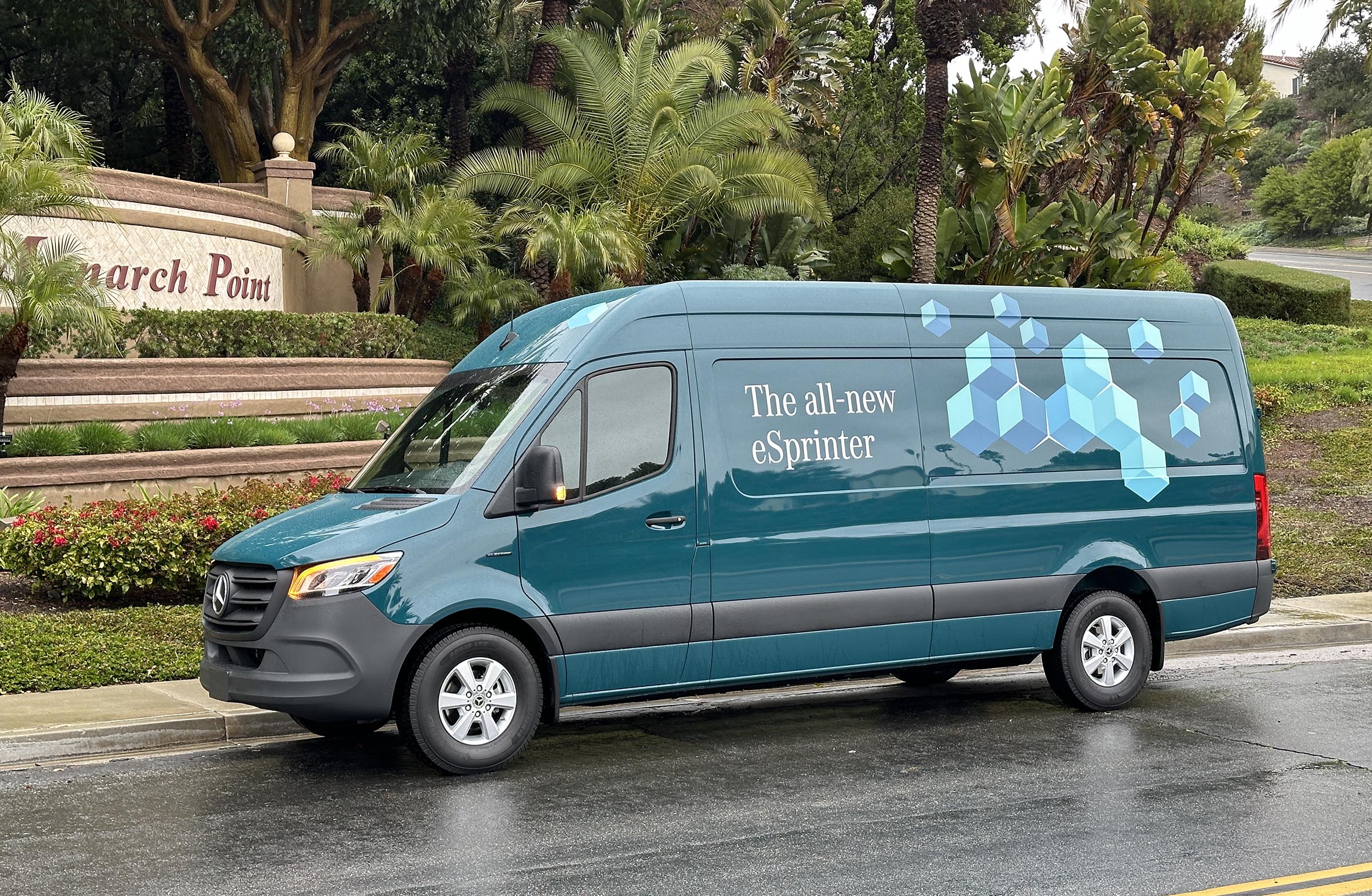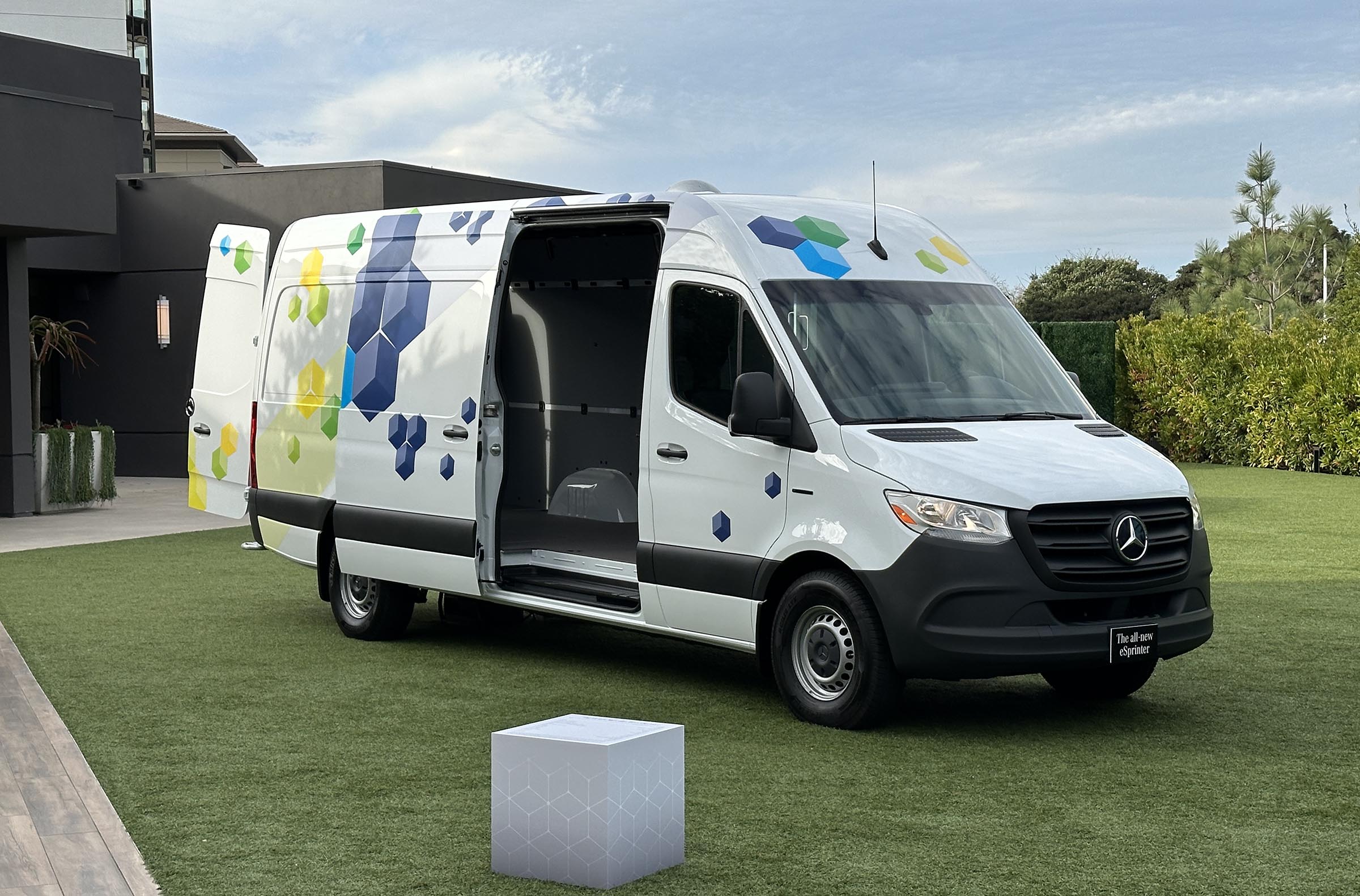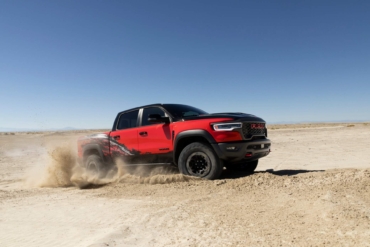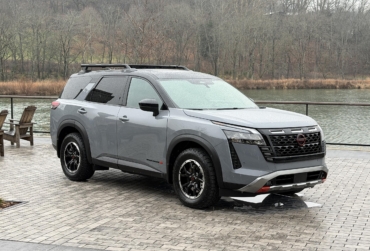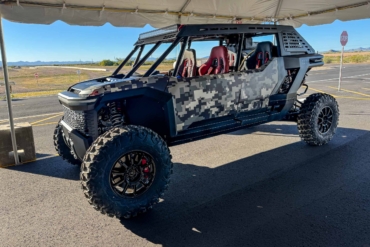Over the decades, Mercedes-Benz has built up a large and loyal following in the U.S. market — and not just for lavishly equipped sedans, coupes, sports cars, and crossovers like the E-Class, SL, and GLE. Its big Sprinter van has carved out a sizable niche among shuttle and delivery services, along with other commercial customers.
After a slow start, the German automaker is making a big push into battery power and that covers both its retail lineup as well as those commercial vehicles. Following the launch of the next-generation Sprinter van last year, Mercedes is rolling out an all-electric version dubbed the eSprinter. I spent a day roaming around Southern California’s Orange County coast to get a feel for what it can deliver.
In short: Even as sales slow a bit in the market for retail battery-electric vehicles, demand continues to accelerate in the van world, primarily driven by last-mile delivery services and shuttles. But there’s growing interest in RV conversions, as well, and that’s a market Mercedes-Benz is exploring as it prepares to launch an all-electric version of the familiar Sprinter line. In a first drive, I was impressed by the capabilities, performance, and range of the 2024 Mercedes-Benz eSprinter.
- Powertrain: Single permanent magnet synchronous electric motor on rear axle
- HP/Torque: 134 hp (Standard Output), 201 hp (High Output), 295 lb.-ft. peak torque for up to 30 seconds
- Battery pack: 113 kWh lithium-ion phosphate
- Range: 215 miles (EPA), 273 miles (WLTP)
- Transmission: Single-speed, RWD
- Cargo: 488 cu.-ft., maximum 2,624 lbs.
- Towing capacity: 4,000 lbs.
Pros
- More extensive range than comparable electric vans
- Low load floor
- Camera mirror
- High roof standard
Cons
- Expensive, starting at $71,886 for basic van
- No current outfitters geared up for RV conversion
- Could use larger sideview mirrors
2024 Mercedes-Benz eSprinter First Drive Review
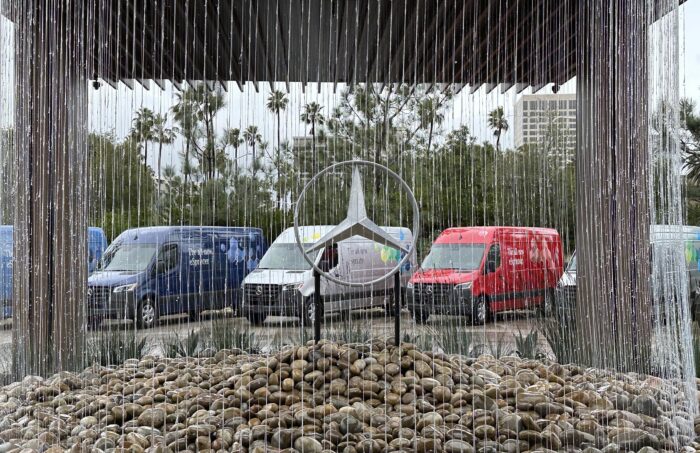
Roomy & Flexible
Like the diesel-powered van, the eSprinter is a big beast. Mercedes chose to electrify the longer version of the Sprinter series, which measures 280 inches in total length, with a 170-inch wheelbase. Width is 92.3 inches including mirrors, and it boasts a height of 107.1 inches — which means all but the tallest NBA players can easily stand up inside.
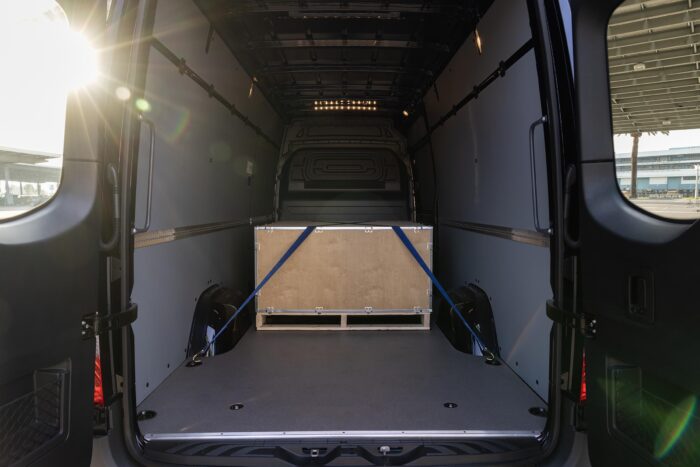
Impressively, the automaker managed to mount both the eSprinter’s battery pack and motor drive system under the van’s load floor, meaning it maintains the diesel model’s hefty 488 cubic feet of cargo capacity.
Customers also should appreciate the flexibility designed into the eSprinter. As with the diesel model, the EV can be outfitted for a seemingly endless series of missions.
There’s huge demand among “last mile” delivery companies to go all-electric. That’s one of eSprinter’s primary target markets, explained Klaus Rehkugler, the head of sales and marketing for Mercedes-Benz Vans. It will go up against comparable, all-electric entries from the likes of Ford, Stellantis, General Motors, and newcomer Rivian. Another key market will be shuttle vans.
As with the regular Sprinter, Mercedes is also “testing the market” for electric conversion vans, added Rehkugler, and is already “talking to upfitters.” Since there’s relatively little difference between Sprinter and eSprinter beyond the powertrain, this should prove an easy process if Mercedes finds potential demand for an electric RV.
Solid Range
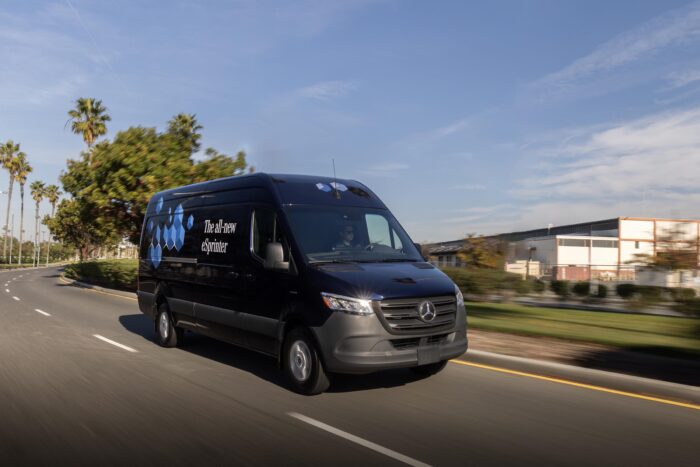
Offering an EPA-estimated 215 miles of range should help. That’s as much as double what some of the other new, all-electric vans are managing on a charge. And, based on my initial experience behind the wheel of the eSprinter, that figure seems to be on target, unlike some of the overly optimistic range estimates that I’ve experienced with other EVs.
The eSprinter draws power from a lithium-ion-phosphate battery pack. LFP cells are a little lower in energy density than more common lithium-ion cells. But they’re more stable, a bit less expensive and, if this is a concern to you, far less likely to catch fire. They are relatively quick to charge, however, which is a definite plus for someone who might want to use an eSprinter for camping or overlanding.

Plugged into a public quick charger of at least 115kW output, the e-van will go from a 10% to 80% state-of-charge in approximately 42 minutes. Using a home 240V charger will take about 12.5 hours to go from fully drained to fully charged.
Reasonable Power
Over the course of a long day, I put the eSprinter through a variety of driving situations around Orange County, from the open freeway to local stop-and-go traffic, as well as some of the tight and hilly roads heading inland. While nowhere near fully loaded, the van carried two adult occupants and 440 pounds of cargo.
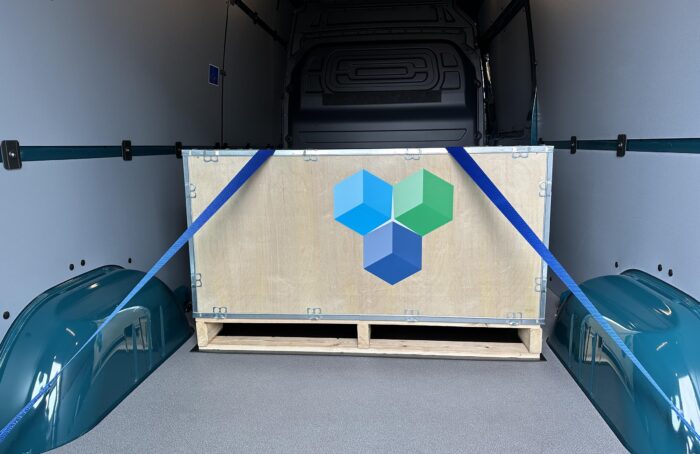
Mercedes sets the maximum cargo weight at 2,464 pounds, while the van also can tow up to 4,000 pounds.
Don’t expect the sort of neck-snapping launch you might get with one of Mercedes’ passenger vehicles. This is no EQS sedan. But it was quicker than I expected and readily able to keep up with traffic, even executing an occasional freeway pass.
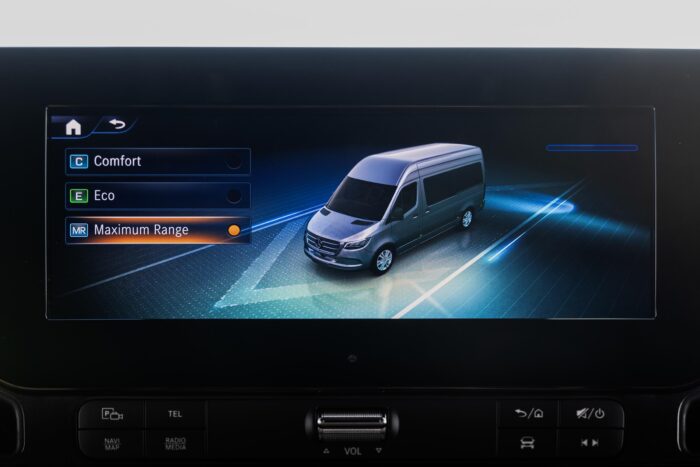
Most of the time I was switched to “Comfort,” the quickest of three drive mode settings. Acceleration was just slightly slower in “Eco” mode, but definitely impacted in the “Range Extender” setting. The good news is that if you need a burst of more power, there’s a way to kick down the throttle enough that you get a brief, additional burst of power.
A single permanent magnet synchronous electric motor is mounted on the rear axle. There are two options, one making 134 horsepower, though I spent the day in the high-output package bumping that to 201 horsepower. Torque peaks at 295 pound-feet for up to 30 seconds.
There’s no all-wheel-drive option. That said, I was pleased by the 2024 Mercedes-Benz eSprinter’s handling, which was put to the test considering the Southern California coast was being pounded by an “atmospheric river” dumping more than 2 inches of rain on the day of my test drive.
Creature Comforts
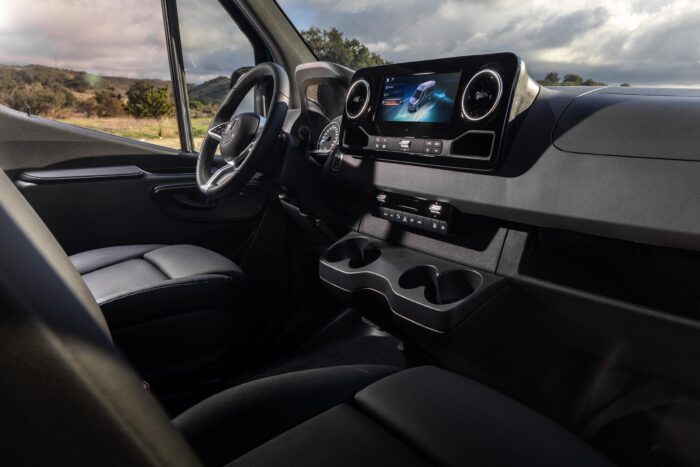
While it may not be an EQS, the eSprinter does deliver some luxury touches, especially when it comes to its tech features. That starts with a cloud-based connected-car system which, for fleet use, can be used to track the van and see not only where it is but how well it’s operating. With optional navigation, it can lay out a route that, if necessary, shows where to charge up along the way.
Buyers can opt for the MBUX, or Mercedes-Benz User Experience. Simply say, “Hey, Mercedes,” and a voice assistant can adjust cabin temperature, change radio stations, set a destination of operate other vehicle functions.
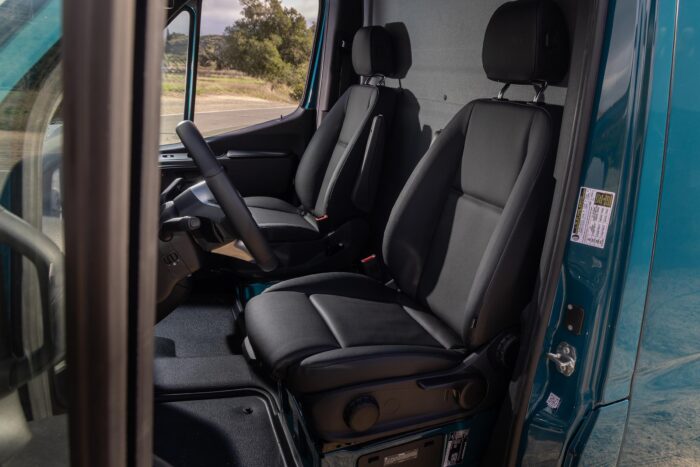
The eSprinter comes with a variety of standard digital safety technologies, including Active Brake Assist and Blind Spot Assist. But one of the most welcome safety features is the optional digital mirror that provides a car-like rearward view of traffic, something that’s not available on most vans. It relies on a high-mounted camera at the back of the van.
On the flip side, I found the side view mirrors a bit smaller than I’d have liked. And, if I’m in complaint mode, another downside with panel van versions of the eSprinter is the limit to seat travel. The bulkhead limits how far back you can slide or lean. With the bulkhead removed, there’s a bit more opportunity to get comfortable.
2024 Mercedes-Benz eSprinter Review: Wrap-Up
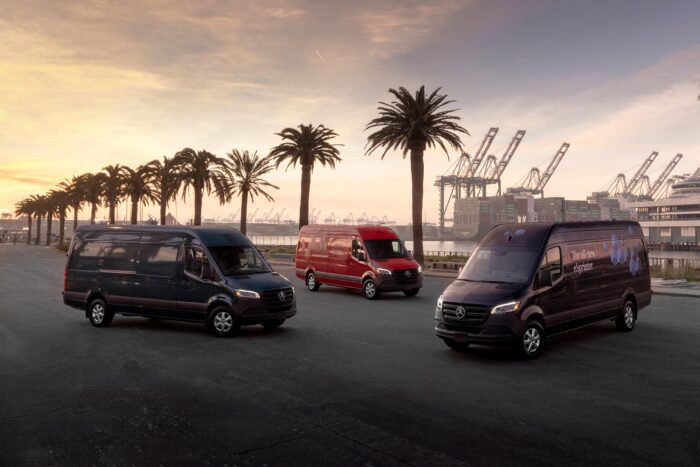
For those who need a commercial-class van but want something that falls into the “green machine” category, Mercedes has done an impressive job swapping out the big Sprinter’s internal combustion engine for an all-electric drive package. It’s essentially a match for the conventional van’s power and performance, and it delivers about the best range in the e-van segment.
As with the regular Sprinter, Mercedes will make it easy to configure eSprinter for a variety of applications. It remains to be seen whether that will formally include camper van options, but there are plenty of upfitters who’ll find it about as easy to set one up as they would with the diesel van.
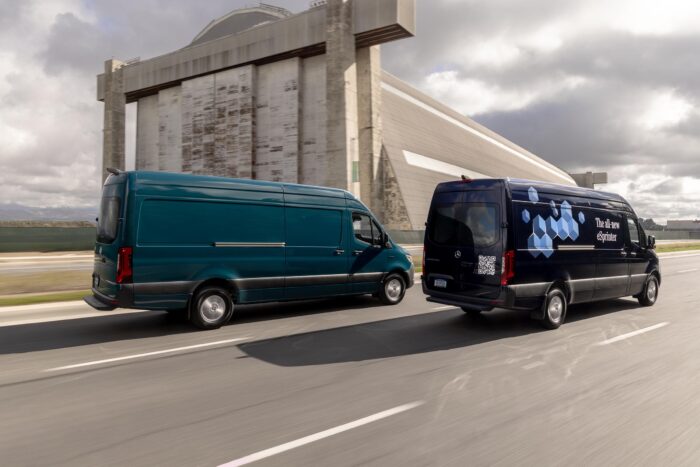
If there’s a downside, it’s price. The eSprinter will start at $71,886 — before factoring in $2,295 in delivery fees. A similarly sized diesel model starts at $53,400, though it offers a few fewer features and less power out of a four-cylinder engine. The high-output diesel jumps to $59,100.
You can now place orders for the 2024 Mercedes-Benz eSprinter van — which will be produced at the automaker’s assembly plant near Charleston, S.C. Deliveries will begin closer to mid-2024.
